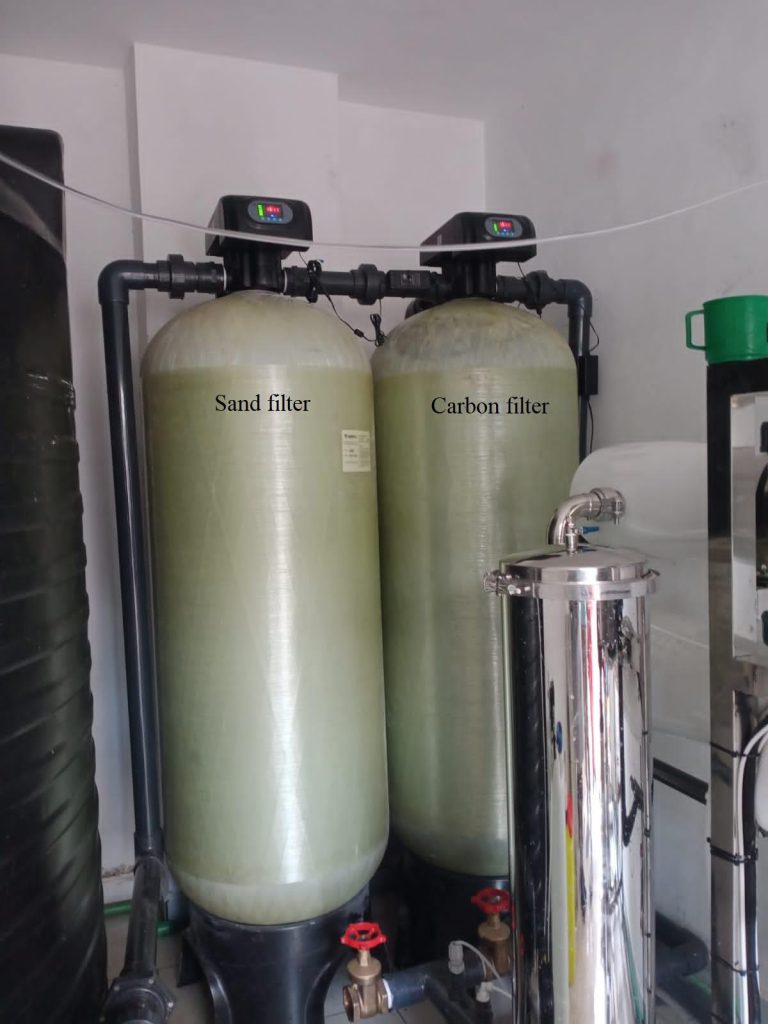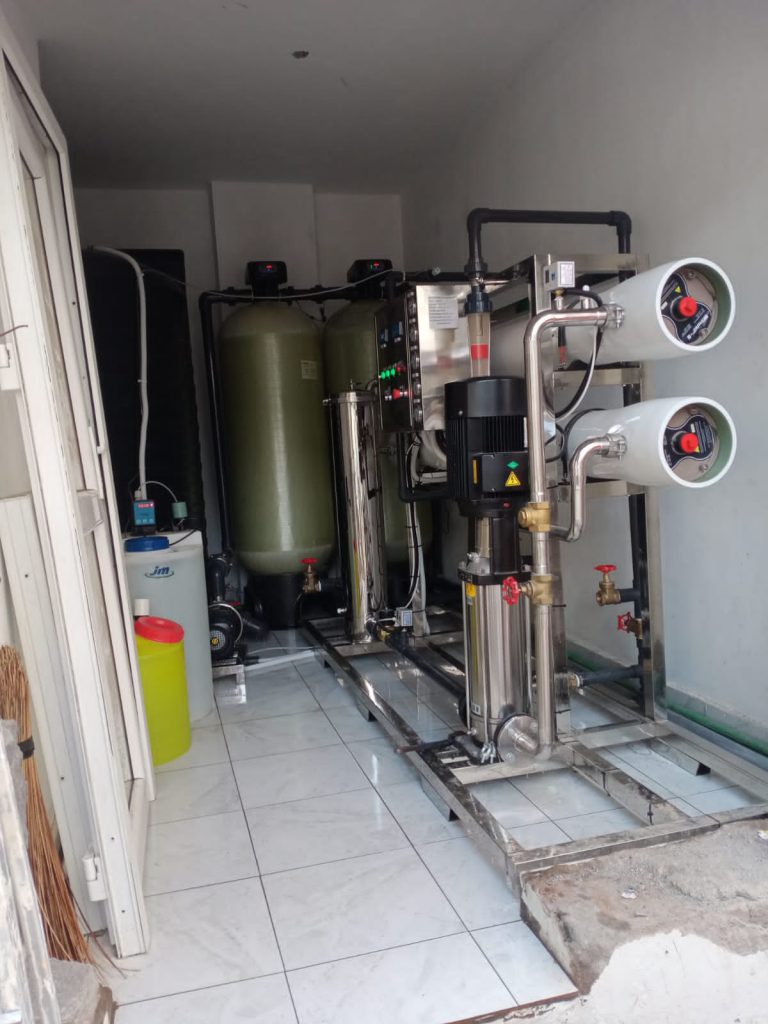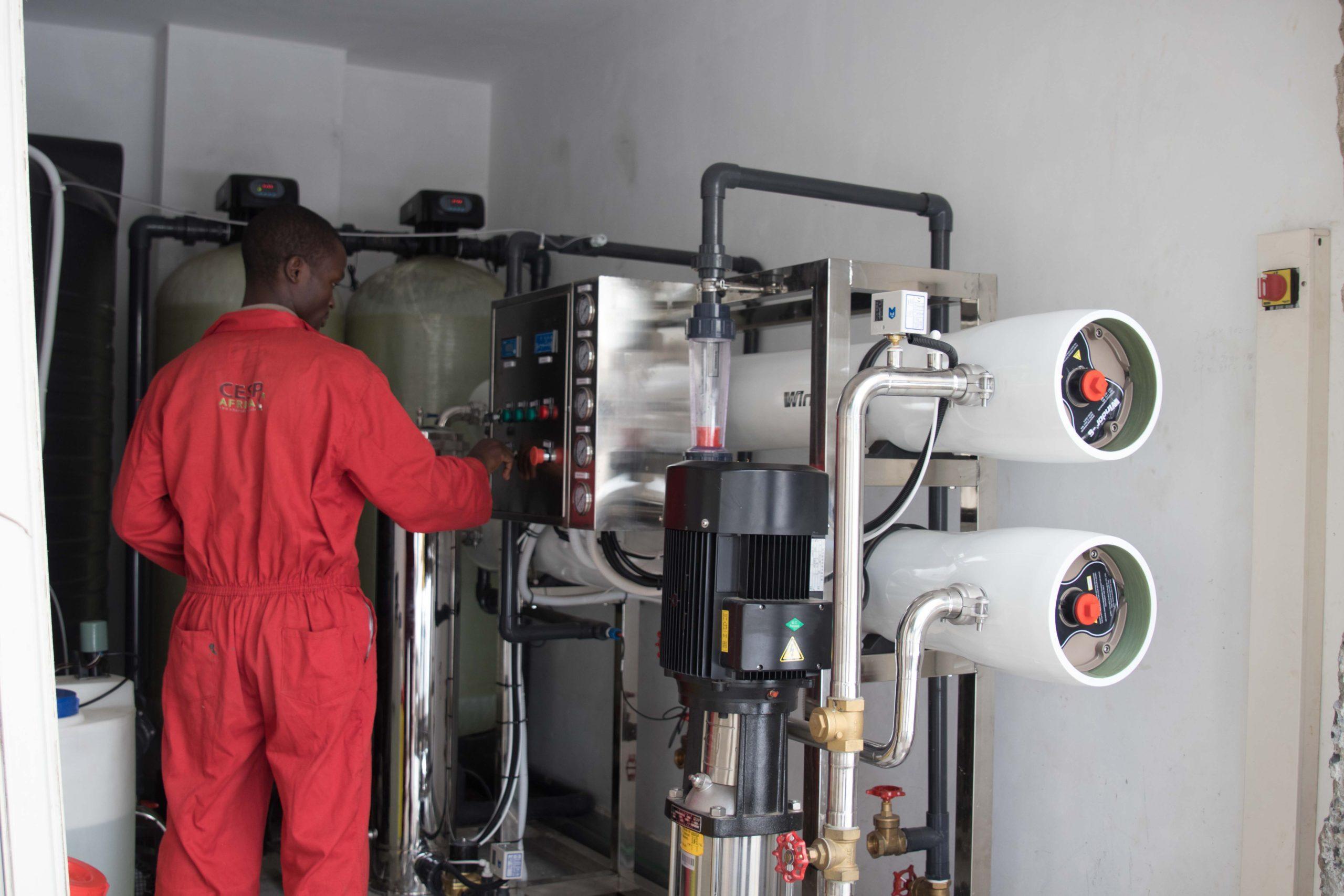Client needs
The client has an apartment complex located in Westlands area. They receive water from Nairobi water, but most of their water is from a borehole.
Their water contained raised amounts of fluoride and suspended solids, as well as discoloration.
System details
The system has a production capacity of 4000Liters per hour.
The system includes: a sand, carbon filter and cartridge filters.
The raw water is pumped through the filters using a feed pump.
The system has an antiscalant dosing tank to protect the reverse osmosis membrane from scaling.
The system has 2 high pressure vessels containing the reverse osmosis membranes.
The system is controlled using a control panel, which also displays details on the system’s production.
Timeline of installation
Installation of the reverse osmosis system took 4 days.
Before actual installation period, water from the apartment is taken for analysis. Results from the analysis informed the treatment of the raw water.


Some pipes were laid and the raw water tank was delivered before the other components were delivered. Power cables were also laid to provide the system with electricity.

During the four-day period the sand and carbon filters were filled and backwashed to remove any impurities that may have been present in the media.
Plumbing was fitted to connect the components of the whole system.
Filtration process.
Raw water passes through the following stages before the final product is produced:
a) Pre-filtration.
b) Antiscalant dosing.
c) Secondary filtration.
d) Reverse osmosis.
e) Chlorination.
The water being treated by this reverse osmosis plant is mainly borehole water. The raw water comes directly from the borehole into a 5000L portable tank that is within the RO room. There is a high-level float switch within the raw water tank that serves to facilitate automatic operation of the borehole pump such that the water does not overflow from the tank upon filling up.
Pre-filtration
Before raw water passes through the reverse osmosis machine, it passes through an assembly of filters comprising a sand filter, carbon filter and cartridge filters. The work of the sand filter is to remove suspended solid particles from the raw water. The carbon filter on the other hand removes smell and taste. Both vessels (sand filter vessel and carbon filter vessel) have got automatic control valves. The cartridge filters assembly is meant to remove any finer suspended solid particles present in the raw water which were not removed by the sand filter.

Antiscaling dosing
There is an antiscalant dosing point after the sand filter and carbon filter and before the raw water gets to the cartridge filter and the RO membranes. Antiscalant dosing is very important as it delays the reaction between Mg, Ca and bicarbonate hence reducing scaling and clogging of the membranes. The antiscalant dosing tank has got a float switch (liquid level control switch) whose function is to ensure that the reverse osmosis machine operates only when there is antiscalant present in the antiscalant tank, otherwise the feed pump and the high-pressure pump will be disengaged. Hence, the RO machine cannot run on inadequate antiscalant as that would be catastrophic to the membranes. The float switch also ensures that the antiscalant dosing pump does not run dry.
Reverse osmosis.
The RO skid has got two pressure vessels and each pressure vessel carries two membranes. Therefore, in total we have four membranes. Purification of water happens by reverse osmosis whereby the permeate is pushed through the semi-permeable membranes and separated from the concentrate after the water has been subjected to a hydrostatic pressure that is greater than the osmotic pressure. The hydrostatic pressure is provided by the high-pressure pump.

The most important parameters on the reverse osmosis skids are the RO inlet pressure, RO outlet pressure and the permeate flowrate. These are indicated on gauges and flowmeters provided on the skid. Permeate flowrate (in cubic meters per hour or simply CMH) dictates the yield or production of the plant.
The concentrate is the unwanted residue and it passes through a separate pipeline to the drainage system of the facility. The permeate on the other hand goes into an underground reservoir via a one-inch pipe. The permeate is the purified water or the wanted product. Within the underground storage tank, there is a high-level float switch whose function is to automatically switch off the RO machine upon filling up of the tank.
Chlorination.
It is on the permeate line that we have a chlorination point. This is where chlorine is dosed by a chlorine dosing pump into the permeate/pure water before it pours into the underground storage tank. The chlorine dosing tank has got a low-level float-switch which is meant to cut off power supply to the chlorine dosing pump to prevent it from running dry.
Training
After we installed the system we trained the care taker on how to monitor and take care of the system. We also provided a one year warranty on the system.




